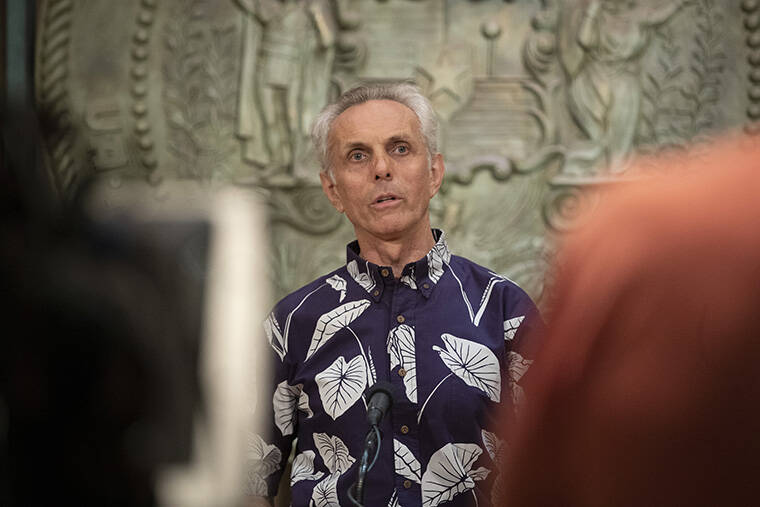
Mahalo for supporting Honolulu Star-Advertiser. Enjoy this free story!
Gov. David Ige announced Wednesday that the state’s response to COVID-19 is transitioning from an emergency mode to public health management.
“I think we all know that COVID- 19 isn’t going away,” said Ige during a press conference. “In fact, case counts are increasing, and the experts expect that COVID will be with us for the foreseeable future. Our response must transition from emergency response to disease management. As part of the transition, COVID will be handled more like other diseases — something health care providers diagnose and treat.”
The state Department of Health on Wednesday reported 3,370 new COVID-19 infections over the previous week, bringing the total since the start of the pandemic to 248,405 cases.
Hawaii’s seven-day average for new cases bumped up for the fifth week in a row, to 362. The positivity rate grew for the sixth consecutive week to 9.1%, according to DOH data. There were also 11 more deaths, bringing the state’s COVID-19 death toll to 1,418.
State Epidemiologist Dr. Sarah Kemble said Hawaii’s average number of cases represents a four-fold increase from mid-March, but is an undercount because results from thousands of home tests are not included in DOH data.
The department expected to see the current rise in cases after the state’s Safe Travels program and the indoor mask mandate were dropped last month, along with the growing presence of more transmissible omicron subvariants.
Recent COVID-19 cases have so far not resulted in a dramatic increase in hospitalizations, though they are a lagging indicator. On Wednesday, DOH reported 51 patients with COVID-19 in Hawaii hospitals, up from 39 the previous week. Only two were in intensive care and two on ventilators.
Caution is still warranted, said Kemble, because it is too soon to conclude that the state is in the clear.
“We must use all the available tools in our toolbox,” she said, which include staying home when sick, getting up-to-date on vaccines and boosters, and being sensible about masking, especially at large, indoor gatherings.
DOH published its “COVID-19 Transition Plan” last week, outlining how it would handle COVID-19 more like other diseases.
DOH Director Dr. Elizabeth Char said the plan lays out three key goals: protecting against and treating COVID-19; deterring and preparing for new variants; and enhancing community resilience.
Instead of mass vaccination clinics, vaccines will be available at pharmacies and health centers or through health care providers. Instead of mass testing clinics, people will be encouraged to use home test kits, which are free by mail from the federal government or reimbursed by insurance.
The plan noted that the transition does not mark the end of the public health response, that the world will not eliminate COVID-19 in the foreseeable future, and that new variants and additional surges are likely.
Also, instead of investigating and contact tracing every case, the focus is on giving people the tools to test at home, to know when to isolate and seek available treatments.
To prevent more hospitalizations, Char urged older, higher-risk patients to consult with their doctors about new COVID-19 treatments, including antiviral pills. The treatments are now widely available by prescription for those at risk of severe illness, she said, though they should not be viewed as substitutes for vaccines.
The number of COVID-19 patients in hospitals has been trending up, according to Hilton Raethel, president and CEO of the Healthcare Association of Hawaii, and is expected to continue rising in coming weeks.
The numbers in intensive care have remained very low, with fewer than two per day, which is a good sign, he said.
However, Hawaii’s hospitals are still full, Raethel said. This week, there were about 2,200 patients in hospital beds, not a lot less than the 2,400 that filled them during the peak of the omicron surge.
“Our hospitals are still busy,” he said. “We are running a census above and beyond what we were doing pre-pandemic.”
In addition, staffing shortages remain an ongoing challenge, particularly at long-term facilities. More than 600 federally funded nurses and health care personnel that were here to help during the omicron surge have gone home.
Hospitals have their own contracts with about 200 mainland health care workers to help make up for the shortage.
Health officials are stressing that Hawaii’s transition to disease management does not mean the pandemic is over, nor that it has reached an endemic phase.
“While we are transitioning, we are still very much in a pandemic,” Char said. Kemble added that if there is still global, uncontrolled transmission of the disease, along with the emergence of new variant strains, there is still a pandemic.
“I would still say we’re in that period of uncertainty,” Kemble said, and realistically, for a “really long time frame.”
Dr. Anthony Fauci, White House adviser, clarified Wednesday that the pandemic is not over after he was widely quoted saying the U.S. was out of the pandemic phase, according to The New York Times. He told National Public Radio he probably should have said the nation was out of the “acute component of the pandemic phase.”
Nationally, CDC’s Data Tracker shows an average of just under 50,000 new COVID-19 cases in the U.S. per day, with hospitalizations trending slightly upward, and deaths trending downward.
The rise is being driven by two new omicron subvariants — BA.2.12 and BA.2.12.1 — detected in New York and numerous other states. Neither had been confirmed in Hawaii as of Wednesday.
But the more contagious subvariant, BA.2, is now dominant in Hawaii, making up at least 70% of new cases. Another subvariant, XE, believed to be more transmissible than BA.2, has also been confirmed in the state.
Char continued to urge people to get vaccinated, boosted, and for those eligible, double boosted. As of Wednesday, 77.2% of Hawaii’s population had completed primary vaccines, with 39.1% boosted.
Ige said he continues to wear a mask at in-person meetings and at large, indoor gatherings. “We all know what we need to do to prevent spreading COVID,” Ige said.
Source: Star Ads



